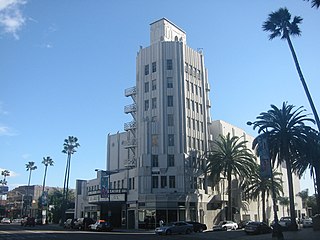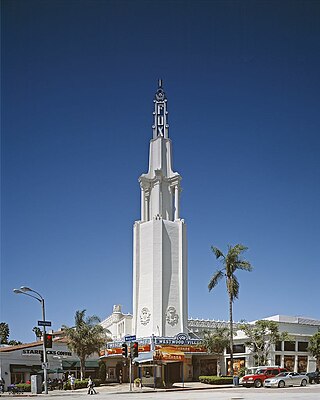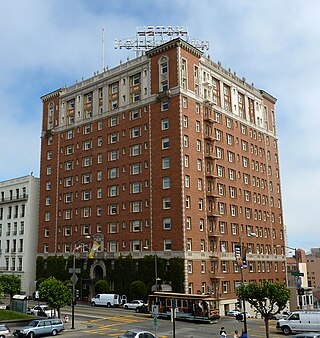Related Research Articles

Streamline Moderne is an international style of Art Deco architecture and design that emerged in the 1930s. Inspired by aerodynamic design, it emphasized curving forms, long horizontal lines, and sometimes nautical elements. In industrial design, it was used in railroad locomotives, telephones, toasters, buses, appliances, and other devices to give the impression of sleekness and modernity.

Fox Theatres was a large chain of movie theaters in the United States dating from the 1920s either built by Fox Film studio owner William Fox, or subsequently merged in 1929 by Fox with the West Coast Theatres chain, to form the Fox West Coast Theatres chain. Fox West Coast went into bankruptcy and was sold to The National Theatres Corporation, led by Charles Skouras, on November 19, 1934, for $17,000,000.00. Eugene Klein later became CEO of National, and turned it into the conglomerate National General. Mann Theatres bought National General's theatres in 1973.

The Saban Theatre is a historic theatre in Beverly Hills, California, formerly known as the Fox Wilshire Theater. It is an Art Deco structure at the southeast corner of Wilshire Boulevard and Hamilton Drive designed by architect S. Charles Lee and is considered a classic Los Angeles landmark. The building was listed on the National Register of Historic Places on April 3, 2012.

The Alex Theatre is a landmark located at 216 North Brand Boulevard in Glendale, California, United States. It is currently owned by the city of Glendale and operated by SAS. The theater's capacity is 1,400.

Broadway, until 1890 Fort Street, is a thoroughfare in Los Angeles County, California, United States. The portion of Broadway from 3rd to 9th streets, in the Historic Core of Downtown Los Angeles, was the city's main commercial street from the 1910s until World War II, and is the location of the Broadway Theater and Commercial District, the first and largest historic theater district listed on the National Register of Historic Places (NRHP). With twelve movie palaces located along a six-block stretch of Broadway, it is the only large concentration of movie palaces left in the United States.

Stiles Oliver Clements was an architect practicing in Los Angeles and Southern California.

Gustave Albert Lansburgh was an American architect largely known for his work on luxury cinemas and theaters. He was the principal architect of theaters on the West Coast from 1900 to 1930.

Timothy Ludwig Pflueger was an architect, interior designer and architectural lighting designer in the San Francisco Bay Area in the first half of the 20th century. Together with James R. Miller, Pflueger designed some of the leading skyscrapers and movie theaters in San Francisco in the 1920s, and his works featured art by challenging new artists such as Ralph Stackpole and Diego Rivera. Rather than breaking new ground with his designs, Pflueger captured the spirit of the times and refined it, adding a distinct personal flair. His work influenced later architects such as Pietro Belluschi.

Paramount Theatre, formerly Metropolitan Theater or Grauman's Metropolitan Theater, also known as Paramount Downtown, was a movie palace and office building located at 323 W. 6th Street and 536 S. Hill Street, across the street from Pershing Square, in the historic core of downtown Los Angeles. It was the largest movie theater in Los Angeles for many years.

The Broadway Theater District in the Historic Core of Downtown Los Angeles is the first and largest historic theater district listed on the National Register of Historic Places (NRHP). With twelve movie palaces located along a six-block stretch of Broadway, it is the only large concentration of movie palaces left in the United States. The same six-block stretch of Broadway, and an adjacent section of Seventh Street, was also the city's retail hub for the first half of the twentieth century, lined with large and small department stores and specialty stores.

Arthur Froehlich, was an American architect in Beverly Hills, California. His firm, Arthur Froehlich & Associates, is known for their mid-century commercial building designs, and thoroughbred horse racetracks.

The Regency Village Theatre is a historic, landmark cinema in Westwood, Los Angeles, California in the heart of the Mediterranean-themed shopping and cinema precinct, opposite the Fox Bruin Theater, near the University of California, Los Angeles (UCLA). The Regency Theaters chain lease ended in July 2024. The Westwood Village Theatre has been the site for many Hollywood movie premieres in Los Angeles. The seating capacity of the cinema is about 1,400.

Weeks and Day was an American architectural firm founded in 1916 by architect Charles Peter Weeks (1870–1928) and engineer William Peyton Day (1886–1966).

The Tower Theatre is a historic movie theater that opened in 1927 in the Broadway Theater District of Downtown Los Angeles.
The Pussycat Theaters were a chain of adult movie theaters, operating between the 1960s and the 1980s. Pussycat Theaters had 30 locations in California and were known for their cat-girl logo. The last one closed in 2022.

The Carthay Circle Theatre was one of the most famous movie palaces of Hollywood's Golden Age. Located on San Vicente Boulevard in Los Angeles, California, it opened in 1926 and was demolished in 1969.

The Tower Theatre for the Performing Arts is a historic Streamline Moderne mixed-use theater in Fresno, California. Built in 1939, it opened to the public on December 15, 1939, under the management of Fox West Coast Theater Corporation. The building was designed by S. Charles Lee, with its tower inspired by the "Star Pylon" at the 1939 New York World's Fair. The theater underwent a renovation and reopened as a performing arts center in 1990, after being closed as a repertory cinema in 1989 due to financial troubles.

Reid & Reid, also known as Reid Brothers, was an American architectural and engineering firm that was active from 1880 to 1932. Established in Indiana by Canadian immigrants, the firm moved to the West Coast and became was the most prominent firm in San Francisco, California in the late 19th and early 20th centuries.
Clarence Justin Smale, also known as C.J. Smale, was an American architect.
References
- ↑ "Movie Theaters Designed by Simeon Charles Lee - Cinema Treasures". cinematreasures.org. Cinema Treasures, LLC. Retrieved 13 July 2016.
- 1 2 3 4 5 6 7 Powell, John Edward (1996). "S. Charles Lee". A Guide to Historic Architecture in Fresno, California. Retrieved 2008-02-04.
- 1 2 3 Scheid, Ann (2000-03-13). "S. Charles Lee: Architect". The S. C. Lee Collection. UCLA Library. Retrieved 2008-02-04.
- ↑ "S. Charles Lee". historicfresno.org. Retrieved 2019-05-11.
- 1 2 3 "Early Views of Hollywood (1920 +)". Water and Power Associates. July 18, 2024. p. 5.
- 1 2 3 "National Register of Historic Places Registration Form - Hollywood Boulevard Commercial and Entertainment District". United States Department of the Interior - National Park Service. April 4, 1985.
- ↑ "Fox Phoenix Theatre". Cinema Treasures. Retrieved 13 July 2016.
- 1 2 "Early Views of Hollywood (1920 +)". Water and Power Associates. Retrieved July 18, 2024.
- ↑ "Lankershim Arts Center". City of Los Angeles Department of Cultural Affairs . Retrieved September 18, 2024.
- ↑ "Terrazzo at State Theatre". www.sohosandiego.org. Save Our Heritage Organization. Retrieved 2024-08-28.
- ↑ "State Theatre in San Diego, CA - Cinema Treasures". cinematreasures.org. Retrieved 2024-08-28.
- 1 2 "California Synagogue in Mission Tradition" (PDF). Architectural Record . 100 (4). Concord, NH and New York, NY: F. W. Dodge Corporation: 104 (PDF p. 96). October 1946. Retrieved 2018-10-19.